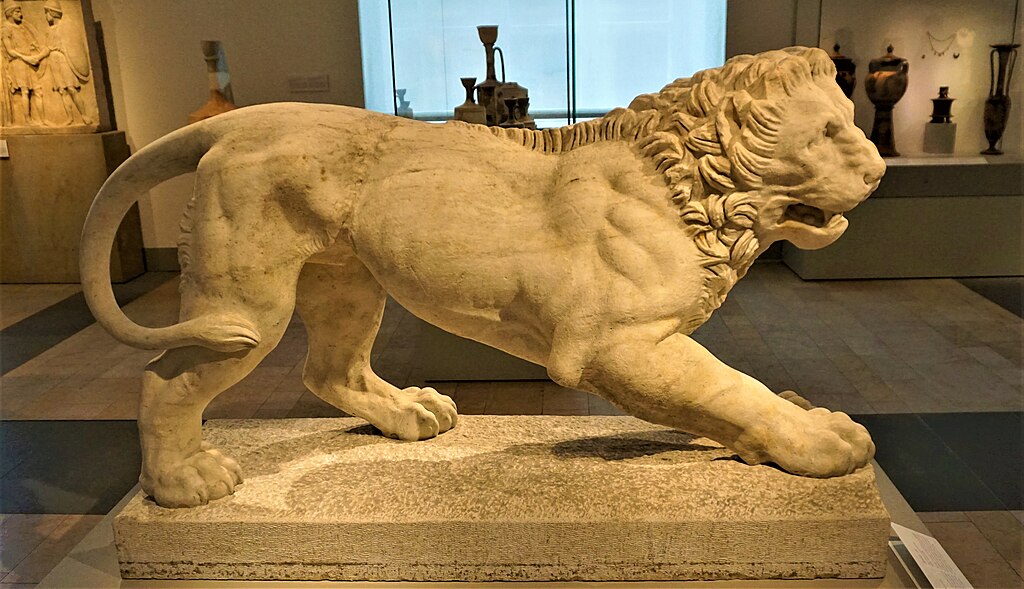
This large Lion marked a grave as a single monument or together with a counterpart as a cornerstone in a monumental tomb district of late classical Athens. The lion is crouching with its head turned to the right and originally provided symbolic protection to a grave. The lion’s face and mane are stylized but realistic. He wrinkles his snout, and his teeth are bared in a snarl. In antiquity, walled family burial plots lined the roads out of Athens. Sculpted lions such as this one, were placed at the corners of the plot and were especially popular in the 300s B.C.
Funerary sculptures had a dual purpose. As a symbolic guardian, the lion provided magical protection from grave robbers plus they served to display the wealth and prestige of the family. The high artistic quality of this lion signifies the high status and wealth of the individual and family.
Funerary Art of Ancient Greece
The ancient Greeks did not generally leave elaborate grave goods, except for a coin to pay the ferryman to Hades, and pottery. Those who could afford them erected stone monuments, which was one of the functions of kouros statues before about 500 BCE. These were not intended as portraits, but during the Hellenistic period, realistic portraiture of the deceased was introduced, and family groups were often depicted in bas-relief on monuments, usually surrounded by an architectural frame. The ostentation of these monuments led to an Athenian law of 317 B.C. that banned all but the simplest of grave markers.
The walls of tomb chambers were often painted in fresco, although few examples have survived in as good condition. Early Greek burials were often marked above ground by a large piece of pottery, and remains were also buried in urns. Pottery continued to be used extensively inside tombs and graves throughout the classical period. The vast majority of surviving ancient Greek pottery is recovered from tombs as were small pottery figurines.
The extension of the Greek world after the conquests of Alexander the Great brought peoples with different traditions into the Hellenistic sphere, resulting in new tomb formats for art in Greek styles. Mausolus was a Hellenized ruler, whose enormous tomb, which began in 353 BC was exceptional in the Greek world. It was the only tomb to be included in the Seven Wonders of the Ancient World. The late 4th-century Alexander Sarcophagus was made for another Hellenized Eastern ruler, one of a number of important sarcophagi found at Sidon.
Reflections
- Is there more Greek Funerary Art in Museums than other types of art?
- What animal would you trust to guard your tomb?
- Why is Funerary Art so much less relevant today?
- Have you ever placed any grave goods in a relatives grave?
Funerary Lion
- Title: Funerary Lion
- Date: 320 BC
- Origins: Athens, Greece
- Medium: Marble
- Type: Marble Sculpture
- Acquired: 1742
- Dimensions: 120 x 200 x 61 cm
- Museum: Altes Museum (German for Old Museum)
Highlights of the Altes Museum
- Torso of a Hoplite Warrior
- Amphora – Depiction of a Funerary Procession
- Statuette of a Horse in Geometric Style
- Statue of Deified Empress Livia
- Votive Relief dedicated to Vesta
- Head of Athena in the Velletri Type
- Funerary Lion
Explore Berlin’s Museums
- The Pergamon Museum
- Neues Museum
- Altes Museum
- Alte Nationalgalerie – National Gallery (Berlin)
- Bode Museum
- Gemäldegalerie, Berlin
- Spy Museum Berlin
- Jewish Museum, Berlin
- Deutsches Historisches Museum – German Historical Museum
- DDR Museum
~~~
“The measure of who we are is what we do with what we have.”
– Ancient Greek Proverb
~~~
Photo Credit: JOM
Popular this Week








 Sponsor your Favorite Page
Sponsor your Favorite Page SEARCH Search for: Search Follow UsJoin – The JOM Membership Program
Sponsor a Masterpiece with YOUR NAME CHOICE for $5
Share this:
- Tweet
